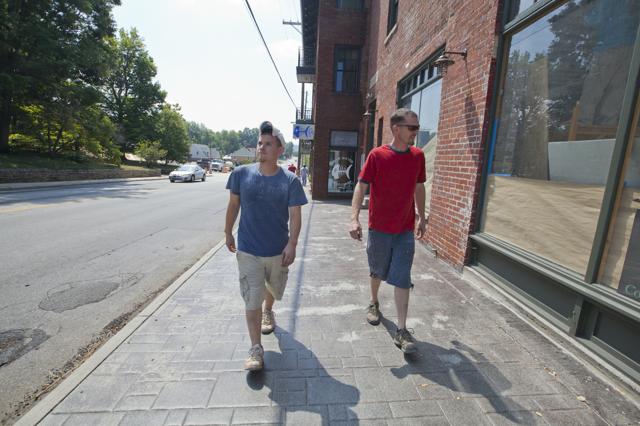North Asheville residents told members of City Council that they don’t want to play chicken with cars anymore when they walk or bike in their neighborhood. Speaking at Council's Aug. 30 community meeting, held at UNCA's Wilma Sherrill Center, residents cited problems with narrow roads, lack of sidewalks and other safety concerns.
“The sidewalks along Merrimon [Avenue] are either nonexistent or largely not safe," resident Billie Buie told the six Council members and about 40 fellow residents who attended the meeting (Mayor Terry Bellamy was absent). Buie, who has helped coordinate efforts to improve walkability along Merrimon, called the route a “big, messy and busy corridor."
Some sections of the thoroughfare are marked by "little foot trails" in the grass, showing where pedestrians try to avoid oncoming traffic, she reported.
Merrimon's nearly three-mile length isn't the only problem corridor. Resident Deborah Pirie reported that Charlotte Street could use some new and improved sidewalks too. Like Buie, she has been involved in helping local business owners, city staff and fellow residents find ways to improve the situation. Part of that effort included a survey sent to residents in three Charlotte Street neighborhoods, Pirie explained.
Eighty people responded to the survey, with 64 percent reporting they did not feel safe walking along Charlotte Street, she noted.
The stretch from Edwin Place to Interstate 240 is a particular problem. That section of Charlotte Street is “a four-lane road [with] two rather narrow sidewalks on either side," said Pirie. To make matters worse: "On one side, utility poles march down the center of the sidewalk," she added.
That's a safety problem, Buie said, reporting that she has witnessed similar challenges on Merrimon Avenue, where people in wheelchairs or pushing a stroller must venture into roadways to get around such obstacles.
Asked what could be done, Asheville Transportation Department Director Ken Putnam noted plans to implement a permit policy that would require the utility companies to notify the city when repairing a pole or replacing it.
For now, utility companies are only required to file a permit when they plan on setting a new pole, but not when they need to replace one, Asheville Public Works Director Cathy Ball explained.
Lakeshore Drive also lacks much-needed sidewalks, perhaps more so than the area's two major routes, north Asheville resident Kelly Wolfe told Council. “I have two children, and I literally have to stroll them in the middle of the street,” she said. “We actually have to get in our car and drive a quarter of a mile to walk around the lake.”
After listening to similar comments and questions, Council member Esther Manheimer acknowledged that sidewalks are a citywide need. She recalled a community meeting that took place this time last year in east Asheville: Held at Groce United Methodist Church’s Asbury Hall, the Aug. 31 meeting attracted more than 300 people, and the fire marshal had to turn away about 150 once the hall reached full capacity. The hot topics of the day were sidewalks and pedestrian safety, primarily along Tunnel Road (See “Whose Side Are You On?” Sept. 8, 2010, Xpress.)
In response to the concerns raised then, the city worked with residents and the North Carolina Department of Transportation to develop a plan and get the funding for some new sidewalks.
Council member Gordon Smith remarked, “This year during our capital improvement project budget, I believe that we doubled the amount of money that we’re going to be putting towards construction on new sidewalks and also increase the maintenance on our existing sidewalks.”
Still, putting in new sidewalks is an expensive and complex endeavor, Council members Jan Davis and Manheimer noted, particularly in these tough economic times. Plans must take into account the gas, water and fiber-optic lines that often run beneath existing sidewalks or where new ones need to go.
Sidewalks must also adhere to specific guidelines set by the Americans with Disabilities Act, which requires that paths be wide enough for wheelchairs and built with materials suitable for them, Putnam added. For example, though less expensive than asphalt, gravel would not be an acceptable material.
And the whole process takes time, said Council member Bill Russell, noting the additional challenge of north Asheville's topography.
But it’s time that Council members are willing to take, Smith assured residents. “We are doing everything we can, within the budget constraints that we have, to be able to address what is in my view a core responsibility of government.”
— Mary Caitlin Byrd is a UNCA journalism student.




Before you comment
The comments section is here to provide a platform for civil dialogue on the issues we face together as a local community. Xpress is committed to offering this platform for all voices, but when the tone of the discussion gets nasty or strays off topic, we believe many people choose not to participate. Xpress editors are determined to moderate comments to ensure a constructive interchange is maintained. All comments judged not to be in keeping with the spirit of civil discourse will be removed and repeat violators will be banned. See here for our terms of service. Thank you for being part of this effort to promote respectful discussion.